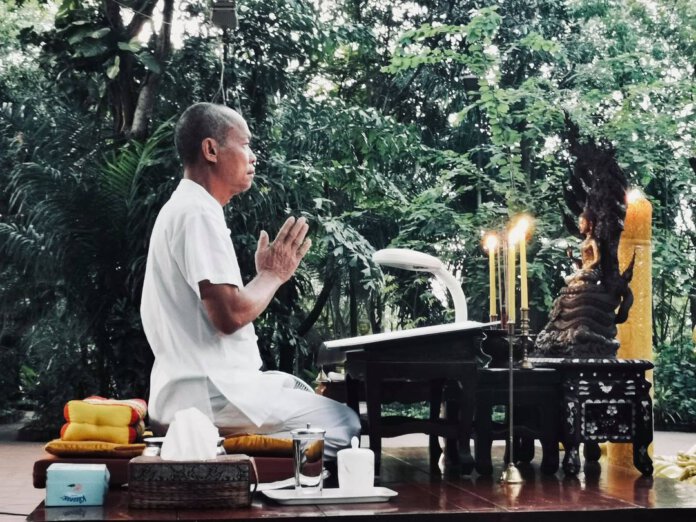มีอะไรอยู่ในพาหุง ๘ ห้อง
๒๖ สิงหาคม ๒๕๖๔
ทำไมโบราณาจารย์ท่านถึงได้ปลูกฝัง สั่งสอนให้ลูกหลานพยายามท่องจำให้คล่องปาก ขึ้นใจ
เราท่านทั้งหลายมาทำความเข้าใจในพรพาหุงทั้ง ๘ ห้องดูกันหน่อย
พาหุง สะหัสสะมะภินิมมิตะสาวุธันตัง
ครีเมขะลัง อุทิตะโฆระสะเสนะมารัง
ทานาทิธัมมะวิธินา ชิตะวา มุนินโท
ตันเตชะสา ภะวะตุ เต ชะยะมังคะลานิ
พระจอมมุนีทรงมีชัยชนะต่อพญามารผู้นิมิตแขนมากตั้งพัน อีกทั้งยังถืออาวุธครบทุกมือ ขี่ช้างชื่อ ครีเมขละ พร้อมทั้งเสนามาร ผู้ซึ่งมีงูออกมาจากร่างกาย พากันลุกรุมล้อมพระจอมมุนี ทั้งยังส่งเสียงโห่ร้องก้องกึก เพื่อรุกไล่ให้พระองค์ลุกหนี ออกจากรัตนบัลลังก์ที่ทรงกระทำความเพียรในค่ำคืนวันตรัสรู้ อนุตตรสัมมาสัมโพธิญาณ องค์พระจอมมุนี ทรงใช้ธรรมวิธีทานบารมี เข้าต่อกรกับพญามารและเสนามาร
โดยทรงยกเอาทานบารมีที่ทรงเคยกระทำมาดีแล้วตั้งแต่อดีตชาติในสี่อสงไขย แสนมหากัป อันมีพระธรณีเป็นพยานรับรู้ ในทานที่ทรงบำเพ็ญ ทุกครั้งก็จักทรงหลั่งน้ำทักษิโณทกอุทิศผลบุญให้แก่สรรพสัตว์
เรื่องนี้ ท่านกล่าวเอาไว้เป็นบุคลาธิษฐาน คือ การยกเอาบุคคลเป็นที่ตั้งว่า ในเวลาที่พระจอมมุนี ทรงยกเอาทานบารมี มาเป็นเครื่องต่อกรกับพญามารและบริวารมารนั้น
ทรงอ้างพระธรณีเป็นพยานรับรู้ทุกครั้ง ที่ทรงบำเพ็ญทาน
พระนางธรณีจึงปรากฏกายตรงด้านหน้า แล้วได้บีบมวยผมที่ซึมซับ ดูดรับ เอาน้ำอุทิศผลทานนั้น ออกมาให้พญามารและเสนามารได้รู้เห็น จนกลายเป็นอุทกธาราไหลบ่าเนืองนอง ดุจดังเขื่อนแตกจนพัดพาพญารมารกระจัดกระจาย พ่ายไปเสียสิ้น
และหากจะว่ากันด้วยหลักธรรมาธิษฐาน คือ การยกเอาธรรมเป็นที่ตั้งเป็นหลักแล้วอธิบาย
ก็ต้องอธิบายว่า การที่พระโพธิสัตว์สิทธัตถะได้ทรงนั่งกระทำความเพียรทางจิต ณ โคนต้นอัมพฤกษ์ ณ ริมฝั่งแม่น้ำเนรัญชรา มหานที ในเวลายามดึกของราตรี ก่อนตรัสรู้
จิตของพระองค์คงต้องเผชิญต่อตัณหา ความทะยานอยาก ความคับแค้น ความเห็นแก่ตัว อุปาทาน ความยึดถือ ที่เข้ามารุมเร้า จนทำให้พระองค์ต้องทรงยกเอาการให้ การเสียสละ การบริจาค มาเป็นเครื่องมือขจัดความทะยานอยาก ความคับแค้น ความเห็นแก่ตัว ความละโมบ ความยึดถือ ซึ่งเป็นประดุจดังมารกองใหญ่ให้ปราชัยลงไปได้ ด้วยอำนาจแห่งการให้ การเสียสละ นั้นคือ ทานบารมี
โบราณาจารย์ท่านจึงสอนให้เจริญ ให้ท่องบทพาหุงบทนี้ จนขึ้นใจ เพื่อเวลาใดที่เราต้องเผชิญจดจ่อต่อความทะยานอยาก ความเห็นแก่ตัว และยึดถือ อันเปรียบประดุจดังมาร ก็ให้เอาชนะด้วยการให้ การเสียสละ การแบ่งปัน
ชัยชนะก็จะเกิดขึ้นแก่ชีวิตตน
เจริญธรรม
พุทธะอิสระ
————————————————-
มีอะไรอยู่ในพาหุง ๘ ห้อง (ตอนที่ ๒)
————————————————–
What is in the Bahum Prayer (Jayamangala Gāthā – the eight victories and blessing)?
Why teachers of ancient times cultivated and taught children to memorize the Bahum Prayer (Jayamangala Gāthā)?
We should try to understand the meaning of the Batum Prayer with its eight parts.
Bāhung sahassa mabhi nimmita sāvu dhantang
Gīri mekhalang udita ghora sasena mārang
Dānādi-dhammavidhinā jitavā munindo
Tang tejasā bhavatu me (te) jaya mangalāni
Lord Buddha conquered Mara, the devil, who created form of thousand arms with weapons, on the elephant named ‘Girimekhala’. Mara together with his evil troops besieged the Buddha and roared frightfully to drive then the Bodhisattva from his seat under the Bodhi tree, while the Bodhisattva was persevering to attain his enlightenment. The Bodhisattva used his height of generosity to fight against the Mara and his evil troops.
The Bodhisattva raised his deeds of generosity he had accumulated in his countless and infinite past lives, witnessed by the earth deity. Every time the Bodhisattva made meritorious deed, he poured water to the earth, as a ceremonial libation to share the accrued merit with all other living beings.
This story has been told by personification. When the Bodhisattva raised his height of generosity to fight against the Mara and his evil troops, because every time he made any meritorious deed in the past, the earth deity witnessed his donation.
Consequently, the earth appeared and twisted her long hair, and torrents of water collected there from the innumerable donative libations of the Buddha over the ages created a flood. The flood washed away Mara and his army.
This story can be explained based on dharma meanings as follows.
At a late night before his enlightenment, while the Bodhisattva was sitting in meditation under the Bodhi Tree by the bank of Neranjana River, his mind was agitated by desires, ambition, resentment, selfishness, and attachments. Therefore, the Bodhisattva had to raise giving, sacrifice, and donation to overcome ambition, resentment, selfishness, and attachments, which were like a huge troop of Mara. The Bodhisattva could conquer the Mara with power of giving and sacrifice, namely the height of generosity.
As a result, ancient teachers taught people to memorize and recite this Bahum Prayer by heart. Whenever we encounter ambition, desire, and attachment which were like the Mara, we can conquer them by giving, sacrifice, and sharing, victory will occur in our lives.
I wish you prosper in Dharma practice.
Buddha Isara
August 26, 2021







